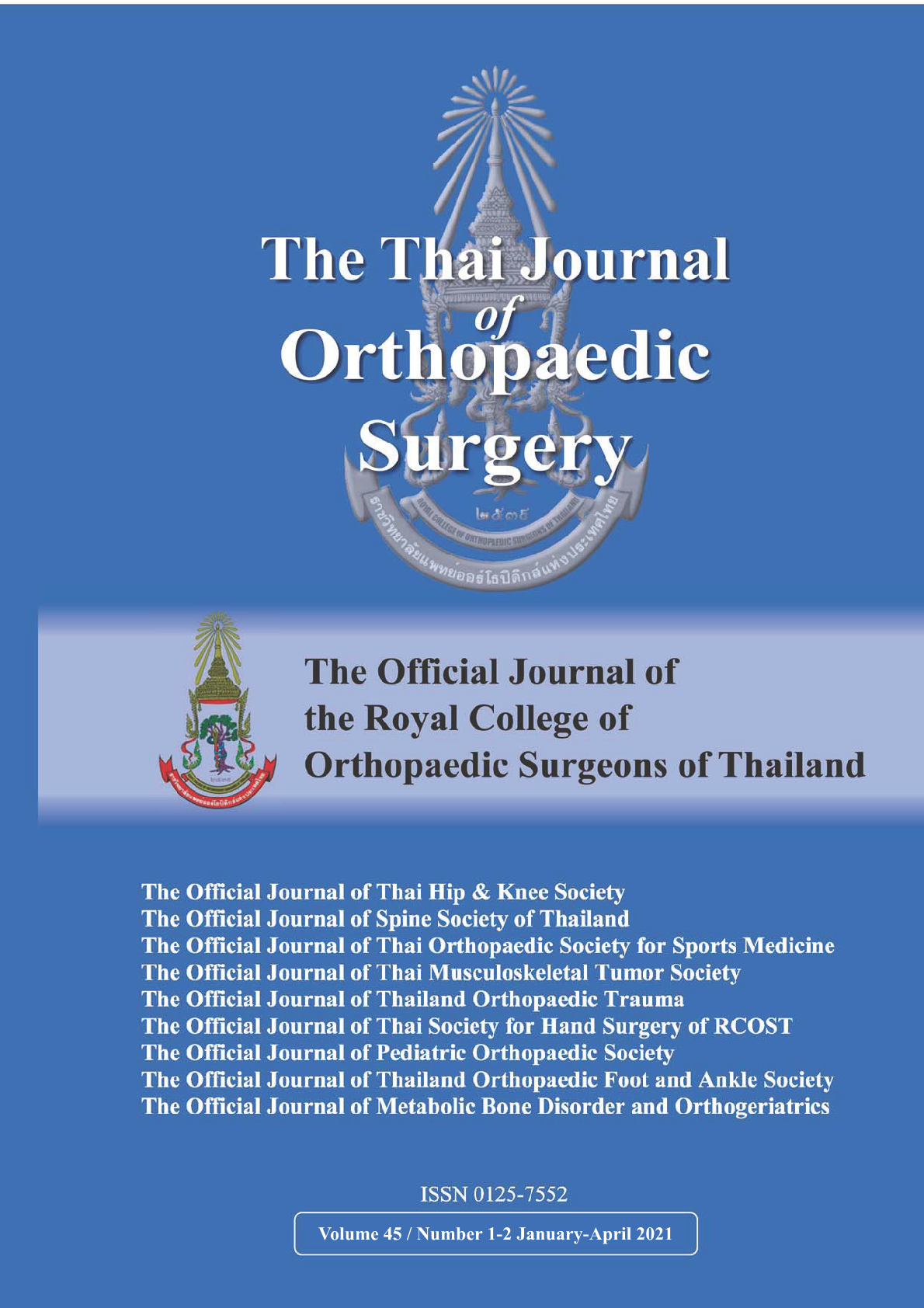ผลของการผ่าตัดแก้ไขกระดูกสันหลังคดในวัยรุ่นชนิดไม่ทราบสาเหตุด้วยเทคนิค Rod Derotation
Main Article Content
บทคัดย่อ
วัตถุประสงค์: เพื่อประเมินผลลัพธ์ของแก้ไขกระดูกสันหลังคดในวัยรุ่นชนิดไม่ทราบสาเหตุ ด้วยเครื่องมือการปรับแนวกระดูกสันหลัง (Smartlink ™) และพิจารณาว่าเครื่องมือนี้มีประสิทธิภาพในการแก้ไขความผิดปกติของกระดูกสันหลังคดในวัยรุ่นชนิดไม่ทราบสาเหตุ หรือไม่
วิธีการศึกษา: ตรวจสอบผู้ป่วยกระดูกสันหลังคดในวัยรุ่นชนิดไม่ทราบสาเหตุ 28 รายย้อนหลัง ผู้ป่วยทุกรายได้รับการผ่าตัดเชื่อมกระดูกสันหลังและการแก้ไขความผิดปกติโดยใช้เทคนิค Rod Derotation ผู้ป่วยมีอายุ 12-23 ปี (เฉลี่ย 16.6 ปี) ระยะเวลาติดตามผลการรักษาเฉลี่ย 3 ปี การผ่าตัดทำโดยใช้เครื่องมือ Smartlink ™ จัดแนวกระดูกสันหลัง ร่วมกับระบบคอมพิวเตอร์นำวิถีและเครื่องมือตรวจสอบความสมบูรณ์ของเส้นประสาท
ผลการศึกษา: ไม่มีผู้ป่วยที่มีภาวะแทรกซ้อนร้ายแรงในผู้ป่วยทั้งหมด ผลการแก้ไขความผิดปกติตามการแบ่งประเภทของ Lenke ชนิดที่ 1 พบว่าความผิดปกติได้รับการแก้ไขในระนาบแบ่งหน้าหลังโดยเฉลี่ยร้อยละ 87 ใน Lenke ชนิดที่ 2 ความผิดปกติได้รับการแก้ไขในระนาบแบ่งหน้าหลังโดยเฉลี่ยร้อยละ 80 ในทรวงอกหลักและร้อยละ 66 ในทรวงอกใกล้เคียง ใน Lenke ชนิดที่ 3 ความผิดปกติได้รับการแก้ไขในระนาบแบ่งหน้าหลังของทรวงอกหลักร้อยละ 80 และ thoracolumbar / lumbar ร้อยละ 82 ใน Lenke ชนิดที่ 5 ค่าเฉลี่ยความผิดปกติของทรวงอก / เอวที่ได้รับการแก้ไขร้อยละ 90 ใน Lenke ชนิดที่ 6 ค่าเฉลี่ยความผิดปกติของทรวงอก / เอวที่ได้รับการแก้ไขร้อยละ 89 และค่าเฉลี่ยทรวงอกหลักที่ได้รับการแก้ไขร้อยละ 87
สรุป: การใช้การปรับแนวกระดูกสันหลังด้วย Smartlink™ ให้ผลลัพธ์ที่ดีสำหรับการแก้ไขความผิดปกติของกระดูกสันหลังคดในวัยรุ่นชนิดไม่ทราบสาเหตุ และปลอดภัยเมื่อใช้ร่วมกับระบบคอมพิวเตอร์นำวิถีและเครื่องมือตรวจสอบความสมบูรณ์ของเส้นประสาทในระหว่างการใส่สกรูเพื่อแก้ไขความผิดปกติกระดูกสันหลัง
Article Details
References
2. Konieczny MR, Senyurt H, Krauspe R. Epidemiology of adolescent idiopathic scoliosis. J Child Orthop. 2013; 7: 3-9.
3. Nissinen M, Heliovaara M, Ylikoski M, Poussa M. Trunk asymmetry and screening for scoliosis: A longitudinal cohort study of pubertal schoolchildren. Acta Paediatr. 1993; 82: 77-82.
4. Taylor TKF, Cumming RG, Jones FL, McCann RG, Plunkett-Cole M. The epidemiology and demography of adolescent idiopathic scoliosis. Spine: State of the Art Reviews. 2000; 14: 305-11.
5. Lenke LG, Betz RR, Harms J, Bridwell KH, Clements DH, Lowe TG, et al. Adolescent idiopathic scoliosis: a new classification system to determine extent of spinal arthrodesis. J Bone Joint Surg Am. 2001; 83: 1169-81.
6. Poitras B, Mayo NE, Goldberg MS, Scott S, Hanley J. The Ste-Justine adolescent idiopathic scoliosis cohort study. Part IV: Surgical correction and back pain. Spine (Phila Pa 1976). 1994; 19: 1582-8.
7. Weinstein SL, Zavala DC, Ponseti IV. Idiopathic scoliosis: long-term follow-up and prognosis in untreated patients. J Bone Joint Surg Am. 1981; 63: 702-12.
8. Harrington PR. Treatment of scoliosis: correction and internal fixation by spine instrumentation. J Bone Joint Surg Am. 1962; 44-A: 591-610.
9. Cotrel Y, Dubousset J, Guillaumat M. New universal instrumentation in spinal surgery. Clin Orthop Relat Res. 1988; 227: 10-23.
10. Dubousset J, Cotrel Y. Application technique of Cotrel-Dubousset instrumentation for scoliosis deformities. Clin Orthop Relat Res. 1991; (264): 103-10.
11. Lee S-M, Suk S-I, Chung E-R. Direct vertebral rotation: a new technique of three-dimensional deformity correction with segmental pedicle screw fixation in adolescent idiopathic scoliosis. Spine (Phila Pa 1976). 2004; 29: 343-9.
12. Kadoury S, Cheriet F, Beauséjour M, Stokes IA, Parent S, Labelle H. A three - dimensional retrospective analysis of the evolution of spinal instrumentation for the correction of adolescent idiopathic scoliosis. Eur Spine J. 2009; 18: 23-37.
13. Suk SI, Lee CK, Kim WJ, Chung YJ, Park YB. Segmental pedicle screw fixation in the treatment of thoracic idiopathic scoliosis. Spine (Phila Pa 1976). 1995; 20: 1399-405.
14. Lenke LG, Edwards CC II, Bridwell KH. The Lenke classification of adolescent idiopathic scoliosis: how it organizes curve patterns as a template to perform selective fusions of the spine. Spine (Phila Pa 1976). 2003; 28: S199-207.

